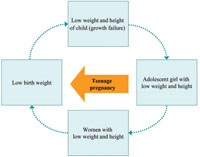6.4.1 Immediate causes of malnutrition
The immediate causes associated with malnutrition include poor diet and disease.
Poor diet: If a child doesn’t get an adequate diet they will become malnourished. The poor diet might be due to not enough food, or a lack of variety of foods in meals; low concentrations of energy and nutrients in meals; infrequent meals; insufficient breastmilk; and early weaning.
Disease: Diseases, especially infectious diseases, cause undernutrition because a sick child may not eat or absorb enough nutrients, or may lose nutrients from the body due to vomiting or diarrhoea, or have increased nutrient needs which are not met.
The diseases most likely to cause undernutrition are: measles; diarrhoea; AIDS; respiratory infections; malaria; and intestinal worms.
Look at Figure 6.6 (the malnutrition-infection cycle). This shows the relationship between infection and undernutrition. As you can see from the figure, infection will lead to undernutrition and the undernutrition also leads to infection.
6.4 Causes of malnutrition

